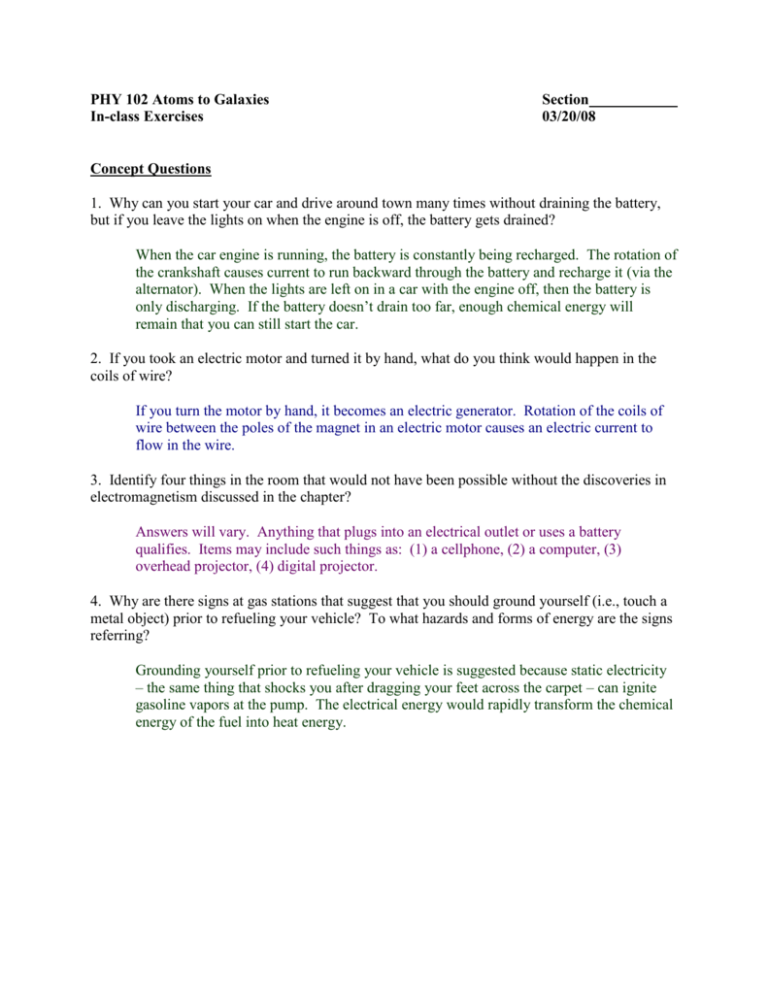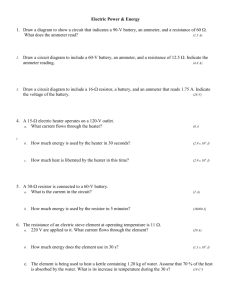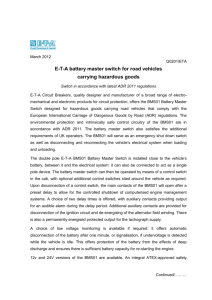PHY 102 Atoms to Galaxies
advertisement

PHY 102 Atoms to Galaxies In-class Exercises Section 03/20/08 Concept Questions 1. Why can you start your car and drive around town many times without draining the battery, but if you leave the lights on when the engine is off, the battery gets drained? When the car engine is running, the battery is constantly being recharged. The rotation of the crankshaft causes current to run backward through the battery and recharge it (via the alternator). When the lights are left on in a car with the engine off, then the battery is only discharging. If the battery doesn’t drain too far, enough chemical energy will remain that you can still start the car. 2. If you took an electric motor and turned it by hand, what do you think would happen in the coils of wire? If you turn the motor by hand, it becomes an electric generator. Rotation of the coils of wire between the poles of the magnet in an electric motor causes an electric current to flow in the wire. 3. Identify four things in the room that would not have been possible without the discoveries in electromagnetism discussed in the chapter? Answers will vary. Anything that plugs into an electrical outlet or uses a battery qualifies. Items may include such things as: (1) a cellphone, (2) a computer, (3) overhead projector, (4) digital projector. 4. Why are there signs at gas stations that suggest that you should ground yourself (i.e., touch a metal object) prior to refueling your vehicle? To what hazards and forms of energy are the signs referring? Grounding yourself prior to refueling your vehicle is suggested because static electricity – the same thing that shocks you after dragging your feet across the carpet – can ignite gasoline vapors at the pump. The electrical energy would rapidly transform the chemical energy of the fuel into heat energy. Problems: 1. Many bonds between atoms result from the attraction of positively and negatively charged atoms. Based on electrical charges and separations, which of the following atomic bonds is strongest? [Hint: You are interested only in the relative strengths, which depend only on the relative charges and distances.] The strongest bond corresponds to the pair of charged atoms that experiences the largest electric force. The electric force is given by Coulomb’s law: F kq1 2q 2 , where k is the d 9 2 2 coulomb constant and is equal to k = 9.00 × 10 N·m /C . a. a +1 sodium atom separated by 4.0 distance units from a –1 chlorine atom in table salt F k (1)(-1) 0.0625 k (4.0) 2 b. a +1 hydrogen atom separated by 2.0 distance units from a –2 oxygen atom in water F k (1)(-2) 0.5 k (2.0) 2 c. a +4 silicon atom separated by 3.0 distance units from a –2 oxygen atom in glass F k (4)(-2) 0.889 k (3.0) 2 The attractive electric force described in atomic bond (c.) is the largest of the three, and therefore bond (c.) is the strongest. 2. A current of 2 amps flows through a wire with a resistance of 10 ohms. What is the voltage of this circuit? I = V / R => V = I × R = (2 A) × (10 ) = 20 V 3. A flashlight uses two 1.5-volt batteries to light a 5-watt bulb. What is the current when the flashlight is on? What is the resistance of the circuit? P = I × V, so, current I = P / V = (5 W) / (2 × 1.5 V) = (5 W) / (3 V) = 1.67 A I = V / R, so, resistance R = V / I = (3 V) / (1.67 A) = 1.8 4. When a video camera’s nickel cadmium (Ni-Cad) or nickel metal hydride (Ni-MH) battery runs down, it is recharged by running current through it backward. Typically, you might run a current of 4 mA (milliamps) at 6 volts for an hour. How much energy does it take to recharge this battery? E = P × t = I × V × t = (4 mA)(6 V)(1 hr) = (6 V) (4 × 10-3 A) (1 hr) (3600 s/hr) = 86.4 J 5. Most household circuits have fuses or circuit breakers that open a switch when the current in the circuit exceeds 15 amps. Would the lights go off when you plug in an air-conditioner (2 kW), a TV (450 W), and four 60-watt light bulbs? Why? P = I × V, so, current I = P / V The total power used for all these items is: P = 2000 W + 450 W + 4(60 W) = 2690 W Then, I = P / V = 2690 W / 115 V = 23.4 A This exceeds the current allowed through the circuit breaker, so the lights would go off. 6. An energy-efficient water heater draws 12 amps in a standard 115-volt circuit. It costs $75 more than a standard water heater that draws 15 amps. If electricity costs 10 cents per kilowatthour, how long would you have to run the efficient water heater to recoup the difference in price? To recoup the $75, you have to run the heater for the amount of time it takes to save $75 worth of electricity: P=E/t so, t = E / P The amount of power saved by using the more efficient water heater is the difference between the power used by each heater: Peff = I × V = (12 amps) ( 115 V) = 1380 W Pstand = I × V = (15 amps) ( 115 V) = 1725 W Power saved, P = 1725 W – 1380 W = 345 W Then, expressing energy E in terms of the cost per kW·h unit of energy: t = (1 kW·h / $0.10) ($75) / 345 W = (1000 W·h / $0.10) ($75) / 345 W = 2174 h (1 day / 24 h) ≈ 91 days ≈ 3 months









